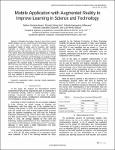Mostrar el registro sencillo del ítem
Contribution of Augmented Reality in Teaching and Learning, in the Midst of COVID-19: Systematic Review
| dc.contributor.author | Chamorro Atalaya, Omar | |
| dc.contributor.author | Morales Romero, Guillermo | |
| dc.contributor.author | Quispe Andía, Adrián | |
| dc.contributor.author | Quispe Guía, Shirley | |
| dc.contributor.author | Guía Altamirano, Teresa | |
| dc.contributor.author | Auqui Ramos, Elizabeth | |
| dc.contributor.author | Linares Sánchez, Guillermo | |
| dc.contributor.author | Sandoval Nizama, Genaro | |
| dc.contributor.author | Arévalo Tuesta, José Antonio | |
| dc.date.accessioned | 2023-10-19T23:59:59Z | |
| dc.date.available | 2023-10-19T23:59:59Z | |
| dc.date.issued | 2023-03-15 | |
| dc.identifier.citation | Chamorro, O., Morales, G., Quispe, A., Quispe, S., Guía, T., Auqui, E., Linares, G., Sandoval, G., & Arévalo, J. A. (2023). Contribution of Augmented Reality in Teaching and Learning, in the Midst of COVID-19: Systematic Review. International Journal of Learning, Teaching and Educational Research, 22(2), 302-322. https://doi.org/10.26803/ijlter.22.2.17 | es_PE |
| dc.identifier.other | . | es_PE |
| dc.identifier.uri | https://hdl.handle.net/11537/34681 | |
| dc.description.abstract | The state of emergency declared in many countries due to the pandemic led universities to consider the incursion of technological tools to give continuity to the teaching and learning process; therefore it is significant to explore results regarding the application of augmented reality (AR) in education. The objective of the research is to generate knowledge from the systematic review of the literature framed in the context of virtual teaching in the midst of COVID-19. A bibliographic review was carried out under a mixed approach, exploratory and descriptive level. The findings showed that the application of AR in learning is not exclusive to any engineering specialty, but, on the contrary, it is versatile and adapts to various curricular contents; Also, the way in which augmented reality is applied is more focused on the use of mobile augmented reality (mobile AR) technology with markerless activation. In addition, it was identified that the factors that were analysed to demonstrate the contribution of AR were: the effectiveness of learning, the predisposition to use AR and the motivation generated by AR. With which it can be concluded that AR in this context has managed to position itself as a learning resource that goes beyond a tool linked to a virtual classroom, since it allows the student to transcend towards immersion in environments with high contextual fidelity. Future research should address which factors influence the improvement of mobile AR activation sensitivity, in different contexts. | es_PE |
| dc.format | application/pdf | es_PE |
| dc.language.iso | spa | es_PE |
| dc.publisher | Society for Research and Knowledge Management | es_PE |
| dc.rights | info:eu-repo/semantics/openAccess | es_PE |
| dc.rights.uri | https://creativecommons.org/licenses/by-nc-sa/4.0/ | * |
| dc.source | Universidad Privada del Norte | es_PE |
| dc.source | Repositorio Institucional - UPN | es_PE |
| dc.subject | Enseñanza virtual | es_PE |
| dc.subject | Realidad aumentada | es_PE |
| dc.subject | Estudiantes de ingenieria | es_PE |
| dc.title | Contribution of Augmented Reality in Teaching and Learning, in the Midst of COVID-19: Systematic Review | es_PE |
| dc.type | info:eu-repo/semantics/article | es_PE |
| dc.publisher.country | PE | es_PE |
| dc.identifier.journal | International Journal of Learning, Teaching and Educational Research | es_PE |
| dc.subject.ocde | https://purl.org/pe-repo/ocde/ford#5.03.01 | es_PE |
| dc.description.sede | Comas | es_PE |
| dc.identifier.doi | https://doi.org/10.26803/ijlter.22.2.17 |






